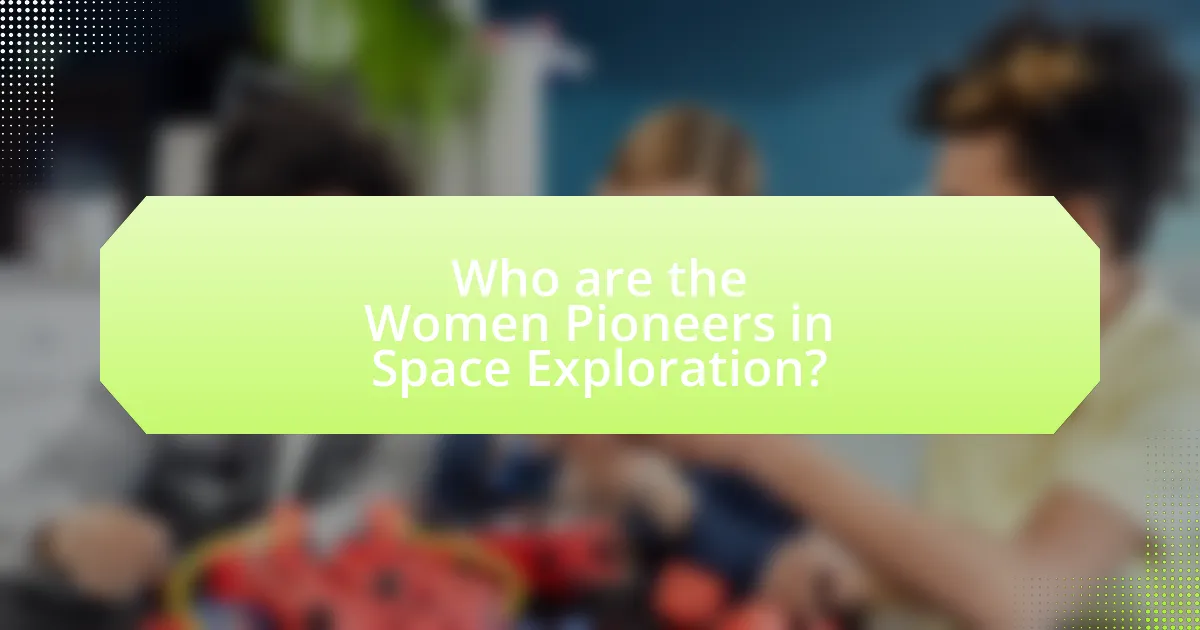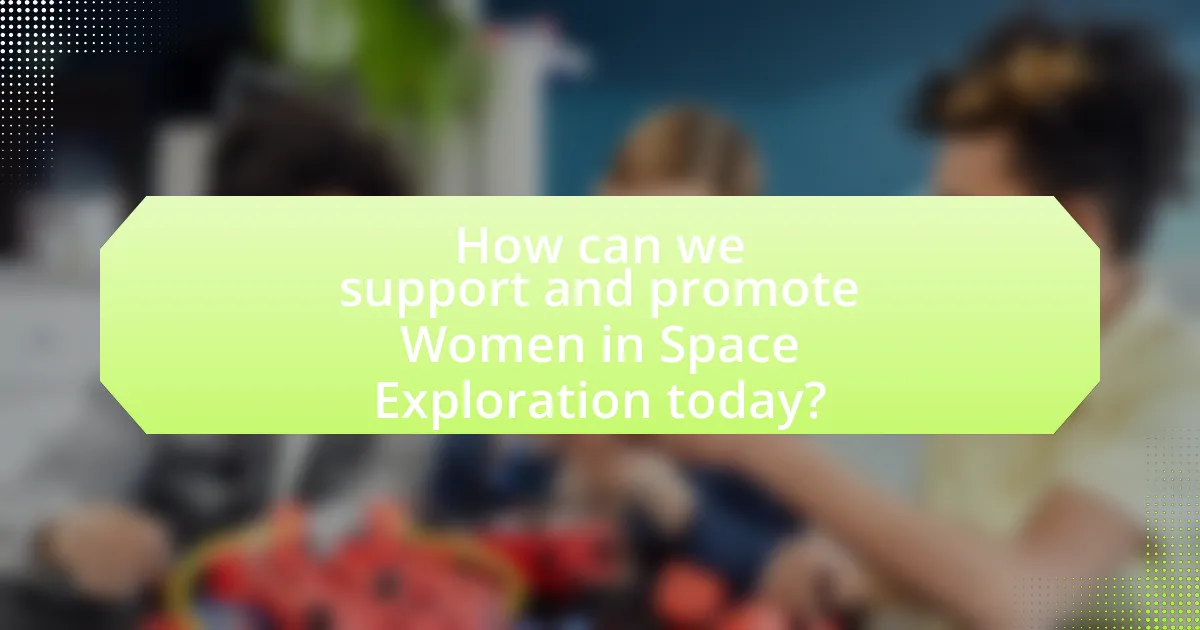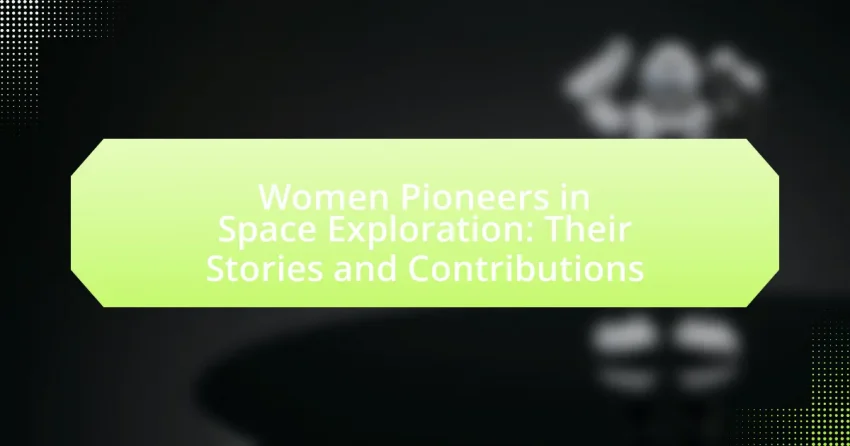The article focuses on women pioneers in space exploration, highlighting their significant contributions and the barriers they overcame in a predominantly male field. Key figures such as Valentina Tereshkova, the first woman in space, and Sally Ride, the first American woman in space, are discussed alongside other influential women like Mae Jemison and Katherine Johnson, who played vital roles in advancing space science and technology. The article also examines the challenges faced by women in this field, the importance of recognizing their achievements, and the initiatives aimed at promoting gender diversity in space exploration. Through their groundbreaking work, these women have not only expanded our understanding of space but have also inspired future generations to pursue careers in STEM.

Who are the Women Pioneers in Space Exploration?
Women pioneers in space exploration include notable figures such as Valentina Tereshkova, the first woman to fly in space in 1963, and Sally Ride, who became the first American woman in space in 1983. Tereshkova’s mission aboard Vostok 6 lasted nearly three days, during which she orbited Earth 48 times, demonstrating women’s capabilities in spaceflight. Sally Ride’s historic flight on the Space Shuttle Challenger marked a significant milestone for women in STEM fields, inspiring future generations. Other influential women include Mae Jemison, the first African American woman in space in 1992, and Eileen Collins, the first female Space Shuttle commander in 1999. These women have made substantial contributions to space exploration, breaking barriers and paving the way for future female astronauts.
What roles have women played in the history of space exploration?
Women have played crucial roles in the history of space exploration, serving as astronauts, engineers, scientists, and advocates. Notable examples include Valentina Tereshkova, the first woman in space in 1963, and Sally Ride, who became the first American woman in space in 1983. Additionally, women like Katherine Johnson, whose calculations were vital for NASA’s early missions, and Mae Jemison, the first African American woman in space in 1992, have significantly contributed to the field. Their achievements have paved the way for future generations of women in STEM and space exploration, demonstrating the essential impact of women in advancing space science and technology.
Which notable women were the first to break barriers in space travel?
Valentina Tereshkova was the first woman to travel to space, launching on June 16, 1963, aboard Vostok 6. She orbited the Earth 48 times during her three-day mission, making her a significant figure in space exploration history. Sally Ride became the first American woman in space on June 18, 1983, flying aboard the Space Shuttle Challenger on STS-7. Both women broke gender barriers in a predominantly male field, paving the way for future generations of female astronauts.
How did these women contribute to the early stages of space programs?
Women significantly contributed to the early stages of space programs through their roles in mathematics, engineering, and piloting. Notably, Katherine Johnson, a mathematician at NASA, calculated trajectories for the first American in space, Alan Shepard, and later for the Apollo missions, ensuring their success. Similarly, Mary Jackson and Dorothy Vaughan were instrumental in advancing computational techniques and engineering practices that supported early space missions. Their work laid the groundwork for future advancements in aerospace technology and human spaceflight, demonstrating the critical impact of women in shaping the space exploration landscape.
What challenges did women face in the field of space exploration?
Women in space exploration faced significant challenges, including systemic gender discrimination, limited access to training and opportunities, and societal stereotypes. Historically, organizations like NASA had few female astronauts; for instance, in the early 1980s, only a handful of women were selected for astronaut training programs. This exclusion was often due to prevailing beliefs that women were less capable in technical and physical roles. Additionally, women encountered barriers in securing funding and support for their research and missions, as evidenced by the underrepresentation of women in leadership positions within space agencies. These challenges have gradually diminished over time, but they have significantly impacted women’s contributions and visibility in the field of space exploration.
How did societal perceptions impact women’s participation in space science?
Societal perceptions significantly hindered women’s participation in space science by perpetuating stereotypes that deemed women as less capable in technical and scientific fields. Historically, women faced barriers such as limited access to education and professional opportunities, reinforced by cultural narratives that prioritized male contributions to science and technology. For instance, during the mid-20th century, women were often discouraged from pursuing careers in STEM due to prevailing beliefs that their primary roles should be domestic. This perception was evident in organizations like NASA, where women were initially relegated to support roles rather than being recognized as potential astronauts or scientists. The impact of these societal views is reflected in the underrepresentation of women in space missions and leadership positions, which persisted until the late 20th century when advocacy for gender equality began to challenge these norms.
What obstacles did women overcome to achieve their goals in space exploration?
Women overcame significant obstacles to achieve their goals in space exploration, including gender discrimination, lack of access to education and training, and societal expectations. For instance, during the early years of space programs, women were often excluded from astronaut selection processes due to prevailing stereotypes that deemed them unfit for such roles. Notably, in 1963, Valentina Tereshkova became the first woman in space, breaking barriers in a male-dominated field. Additionally, women like Sally Ride faced challenges such as skepticism about their capabilities and limited support from institutions. The establishment of organizations like the Women in Aerospace in 1985 helped advocate for women’s roles in the industry, further enabling their contributions to space exploration.
Why is it important to recognize women in space exploration?
Recognizing women in space exploration is crucial for promoting gender equality and inspiring future generations. Women have made significant contributions to space missions, such as Sally Ride, the first American woman in space, and Mae Jemison, the first African American woman in space, who both broke barriers and served as role models. Their achievements highlight the importance of diversity in STEM fields, as studies show that diverse teams lead to more innovative solutions and improved problem-solving. Acknowledging these contributions not only honors their legacy but also encourages young girls to pursue careers in science and technology, fostering a more inclusive future in space exploration.
How does their recognition influence future generations of women in STEM?
Recognition of women pioneers in STEM significantly inspires future generations by providing visible role models who demonstrate that success in these fields is attainable. For instance, the achievements of women like Mae Jemison, the first African American woman in space, and Katherine Johnson, whose calculations were critical to NASA’s early space missions, serve as powerful examples. Their stories highlight the importance of perseverance and innovation, encouraging young women to pursue careers in science, technology, engineering, and mathematics. Research indicates that visibility of female role models in STEM can increase girls’ interest in these fields, as evidenced by a study published in the journal “Psychological Science,” which found that girls exposed to female scientists were more likely to express interest in science-related careers. Thus, the recognition of these pioneers not only validates the contributions of women in STEM but also fosters a supportive environment for future generations to thrive.
What impact does highlighting their stories have on the space industry?
Highlighting the stories of women pioneers in space exploration significantly impacts the space industry by promoting diversity and inspiring future generations. This visibility encourages a more inclusive environment, which is essential for innovation and problem-solving in complex fields like space exploration. For instance, studies have shown that diverse teams are more effective, with research from McKinsey indicating that companies with higher gender diversity are 21% more likely to outperform their peers in profitability. By showcasing these women’s contributions, the industry not only acknowledges their achievements but also motivates young women to pursue careers in STEM, ultimately leading to a richer talent pool and enhanced creativity in space missions.

What are the Contributions of Women in Space Exploration?
Women have made significant contributions to space exploration, including pioneering roles in astronautics, engineering, and scientific research. Notable figures include Valentina Tereshkova, the first woman in space in 1963, and Sally Ride, who became the first American woman in space in 1983. Additionally, women like Mae Jemison, the first African American woman in space, and Katherine Johnson, whose calculations were critical to NASA’s early missions, have played vital roles in advancing space science and technology. Their achievements have not only broken gender barriers but have also contributed to the success of numerous space missions, highlighting the essential role of women in the ongoing exploration of space.
How have women contributed to scientific research in space?
Women have significantly contributed to scientific research in space through various roles, including astronauts, engineers, and scientists. Notable figures include Sally Ride, the first American woman in space, who conducted experiments on the Space Shuttle Challenger in 1983, and Mae Jemison, the first African American woman in space, who contributed to medical research during her mission on the Space Shuttle Endeavour in 1992. Additionally, women like Katherine Johnson played crucial roles in calculations for NASA’s early space missions, which were essential for the success of manned flights. Their contributions have advanced our understanding of space and paved the way for future generations of female scientists and astronauts.
What specific missions have women led or participated in?
Women have led and participated in numerous significant space missions, including the Apollo program, the Space Shuttle missions, and the International Space Station (ISS) expeditions. Notably, Sally Ride became the first American woman in space during the STS-7 mission in 1983. Additionally, Eileen Collins commanded the STS-93 mission in 1999, marking the first time a woman led a Space Shuttle flight. In the realm of the ISS, Peggy Whitson served as the first female commander during Expedition 16 in 2007 and holds the record for the longest cumulative time spent in space by an American astronaut, totaling 665 days. These missions exemplify women’s critical roles in advancing space exploration and their contributions to scientific research and international collaboration in space.
How have their contributions advanced our understanding of space?
Women pioneers in space exploration have significantly advanced our understanding of space through their groundbreaking research, missions, and advocacy. For instance, Sally Ride became the first American woman in space in 1983, contributing to our knowledge of microgravity effects on human physiology during her missions aboard the Space Shuttle Challenger. Additionally, Mae Jemison, the first African American woman in space, conducted scientific experiments on the Space Shuttle Endeavour in 1992, enhancing our understanding of the biological effects of space travel. Their contributions have not only expanded scientific knowledge but also inspired future generations of scientists and astronauts, leading to increased diversity and innovation in the field of space exploration.
What technological innovations have women pioneered in space exploration?
Women have pioneered several technological innovations in space exploration, notably in the fields of software engineering, spacecraft design, and mission planning. For instance, Margaret Hamilton developed the onboard flight software for NASA’s Apollo missions, which was crucial for landing humans on the Moon. Additionally, Dr. Ellen Ochoa, as a co-inventor on multiple patents, contributed to optical systems for space exploration, enhancing imaging technology used in spacecraft. Furthermore, women like Dr. Nancy Grace Roman, known as the “Mother of Hubble,” played a significant role in the design and development of the Hubble Space Telescope, which has transformed our understanding of the universe. These contributions underscore the vital role women have played in advancing space technology and exploration.
Which technologies were developed or improved by women in the field?
Women have developed and improved several technologies in the field of space exploration, including software for spacecraft navigation and the development of life support systems. Notably, Margaret Hamilton led the team that created the onboard flight software for NASA’s Apollo missions, which was crucial for landing humans on the Moon. Additionally, Dr. Ellen Ochoa co-invented an optical inspection system that has been used in space missions to enhance the safety and reliability of spacecraft. These contributions have significantly advanced the capabilities and safety of space exploration technologies.
How have these innovations changed the landscape of space missions?
Innovations in technology and methodology have significantly transformed the landscape of space missions by enhancing capabilities, reducing costs, and increasing accessibility. For instance, advancements in reusable rocket technology, exemplified by SpaceX’s Falcon 9, have lowered launch costs by up to 30%, enabling more frequent missions and broader participation from various organizations. Additionally, the development of miniaturized satellites, such as CubeSats, has democratized access to space, allowing universities and smaller companies to conduct research and experiments in orbit. These innovations not only expand the scope of missions but also foster collaboration and diversity in the field, exemplified by the increasing involvement of women in leadership roles within space agencies and private companies.
What leadership roles have women taken in space agencies?
Women have taken significant leadership roles in space agencies, including positions such as NASA Administrator, European Space Agency Director General, and heads of various mission directorates. For instance, NASA’s first female Administrator, Janet Napolitano, served from 2009 to 2013, while the European Space Agency appointed its first female Director General, Jan Wörner, in 2015. Additionally, women like Ellen Ochoa, who became the first Hispanic woman in space, have held leadership roles in NASA’s Johnson Space Center. These positions demonstrate the increasing influence and contributions of women in shaping space exploration initiatives and policies.
Who are the prominent female leaders in organizations like NASA and ESA?
Prominent female leaders in organizations like NASA and ESA include Ellen Ochoa and Jan Wörner. Ellen Ochoa, the first Hispanic woman in space, served as the Director of NASA’s Johnson Space Center and has made significant contributions to space exploration and technology. Jan Wörner, while not female, is notable for his leadership as the Director General of ESA, emphasizing the importance of gender diversity in leadership roles. Additionally, other influential women at NASA include Kathy Lueders, who played a key role in the Commercial Crew Program, and at ESA, Magali Vaissiere, who has been instrumental in various space missions. These leaders exemplify the impact of women in shaping the future of space exploration.
What initiatives have these leaders implemented to promote diversity?
Leaders in space exploration have implemented initiatives such as mentorship programs, diversity hiring practices, and outreach efforts to promote diversity. For instance, NASA’s Artemis program actively seeks to include women and underrepresented minorities in its workforce, aiming for gender parity in astronaut selection by 2024. Additionally, organizations like the Association for Women in Science provide networking and professional development opportunities specifically designed to support women in STEM fields, thereby fostering a more inclusive environment in space exploration. These initiatives are backed by statistics showing that diverse teams enhance innovation and problem-solving capabilities, which are crucial in the complex field of space exploration.

How can we support and promote Women in Space Exploration today?
To support and promote women in space exploration today, organizations and institutions should implement targeted mentorship programs that connect aspiring female scientists and engineers with established professionals in the field. Research indicates that mentorship significantly enhances career development and retention rates for women in STEM, with studies showing that women with mentors are more likely to pursue leadership roles. Additionally, increasing visibility of female role models through media campaigns and educational outreach can inspire the next generation of women to enter space exploration. For instance, NASA’s Artemis program aims to land the first woman on the Moon, highlighting female contributions and encouraging young women to pursue careers in aerospace.
What programs exist to encourage young women to pursue careers in space science?
Programs that encourage young women to pursue careers in space science include NASA’s “Girls in STEM” initiative, which provides mentorship and hands-on experiences in science, technology, engineering, and mathematics. Additionally, the “Women in Aerospace” organization offers scholarships and networking opportunities specifically aimed at young women interested in aerospace careers. The “Space Camp” program also features sessions designed for girls, focusing on space science and engineering skills. These programs are supported by statistics showing that women remain underrepresented in STEM fields, with only about 28% of the workforce in science and engineering being female, highlighting the importance of such initiatives.
How can educational institutions better support female students in STEM?
Educational institutions can better support female students in STEM by implementing mentorship programs that connect them with female role models in the field. Research indicates that mentorship significantly enhances the retention and success rates of women in STEM disciplines. For instance, a study published in the Journal of Educational Psychology found that students with mentors reported higher levels of self-efficacy and academic performance. Additionally, institutions can create inclusive curricula that highlight the contributions of women in STEM, fostering a sense of belonging and inspiration among female students. By providing scholarships specifically for women pursuing STEM degrees, schools can also alleviate financial barriers, encouraging more female students to enter these fields.
What can organizations do to create a more inclusive environment in space exploration?
Organizations can create a more inclusive environment in space exploration by implementing targeted recruitment strategies that prioritize diversity and actively seek out underrepresented groups, including women. For instance, NASA’s Artemis program aims to land the first woman and the next man on the Moon by 2024, highlighting a commitment to gender diversity in its workforce. Additionally, organizations can establish mentorship programs that connect experienced professionals with newcomers from diverse backgrounds, fostering an inclusive culture and providing support for career advancement. Research shows that diverse teams enhance innovation and problem-solving, which is crucial in the complex field of space exploration. By promoting inclusive policies and practices, organizations can ensure that all voices are heard and valued, ultimately leading to more successful missions and advancements in the field.
What best practices can be adopted to ensure equal opportunities for women?
To ensure equal opportunities for women, organizations should implement mentorship programs that connect women with experienced professionals in their fields. Research shows that mentorship significantly enhances career advancement and job satisfaction for women, as evidenced by a study published in the Journal of Vocational Behavior, which found that women with mentors are more likely to receive promotions and salary increases. Additionally, organizations should enforce equitable hiring practices and provide training on unconscious bias to create a more inclusive workplace. The World Economic Forum’s Global Gender Gap Report highlights that companies with diverse leadership teams are more innovative and financially successful, reinforcing the importance of equal opportunities for women in all sectors, including space exploration.
How can individuals contribute to the recognition of women in space exploration?
Individuals can contribute to the recognition of women in space exploration by actively promoting their achievements through education, advocacy, and social media engagement. For instance, sharing stories of female astronauts and scientists, such as Sally Ride, the first American woman in space, and Mae Jemison, the first African American woman in space, helps raise awareness of their contributions. Additionally, supporting organizations that focus on women in STEM, like the Association for Women in Science, can amplify their visibility. Engaging in discussions, attending events, and participating in campaigns that highlight women’s roles in space exploration further solidifies their recognition in this field.
What actions can be taken to raise awareness about women’s contributions in this field?
To raise awareness about women’s contributions in space exploration, educational programs can be implemented in schools and universities that highlight the achievements of female astronauts and scientists. For instance, initiatives like the “Women in Space” curriculum developed by NASA showcase the roles of women such as Sally Ride and Mae Jemison, emphasizing their groundbreaking work and inspiring future generations. Additionally, public campaigns through social media platforms can amplify these stories, utilizing hashtags like #WomenInSpace to engage a wider audience and foster discussions around gender equality in STEM fields.
